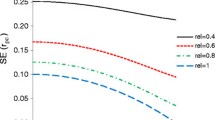Summary
The concept of the genetic correlation for one trait across environments was extended to two environmental factors B and C. Three additive genetic correlations for the same trait were defined: rG, across both environmental factors; rG(B), across C and within B; and rG(C), across B and within C. As genotype x environment variances increase, the genetic correlations across environments decrease. These three genetic correlations are biased downward in the presence of heterogeneity of genetic variances within environments when they are calculated from the usual analysis of variance (r*G, r*G(B), r*G(C)). Correction factors were derived to remove the bias. The two-way genotype by environment interaction variances can be biased upward or downward by the heterogeneity, but the three-way interaction variance is always biased upward. Correction factors for the interaction variances were also derived. Four additive genetic correlations between two traits (X and Y) were derived: rG xy, across both B and C; rG(B) xy, and rG(C) xy, across one environmental factor and within the other; and rG(BC) xy, within both B and C. These concepts were extended to genetic correlations for dominance and maternal effects. Paternal half-sib and factorial mating designs were used to obtain the various genetic correlations. An example of a paternal half-sib design with beef cattle was used to illustrate the methodology.
Similar content being viewed by others
References
Ahlschwede WT, Dillard EU, Legates JE, Robinson OW (1969) Sire-environment interaction effects on steer growth. J Anim Sci 28:130
Barlow R (1981) Experimental evidence for interaction between heterosis and environment in animals. Anim Breed Abstr 49:715–737
Becker WA (1975) Manual of quantitative genetics. Washington State University, Pullman, Wash
Bowman JC (1972) Genotype × environment interactions. Ann Genet Sel Anim 4:117–123
Chapman AB (1968) Genetic-environmental interactions in laboratory and farm animals. In: Hogsett M (ed) Proc 17th Nat Breeders' Roundtable. Kansas City, pp 77–110
Cockerham CC (1963) Estimation of genetic variances. In: Hanson WD, Robinson HF (eds) Statistical genetics and plant breeding. NAS-NRC, Washington DC, pp 53–94
Comstock RE, Moll RH (1963) Genotype-environment interactions. In: Hanson WD, Robinson HF (eds) Statistical genetics and plant breeding. NAS-NRC, Washington DC, pp 164–196
Comstock RE, Robinson HF (1948) The components of genetic variance in populations of biparental progenies and their use in estimating the average degree of dominance. Biometrics 4:254–266
Cundiff LV (1972) The role of maternal effects in animal breeding. 8. Comparative aspects of maternal effects. J Anim Sci 35:1335–1337
Dickerson GE (1962) Implications of genetic-environmental interaction in animal breeding. Anim Prod 4:47–64
Dingle H, Hegmann JP (1982) Evolution and genetics of life histories. Springer, Berlin Heidelberg New York
Eisen EJ, Bohren BB, McKean HE (1963) Source and age of pullets and storage of eggs as factors affecting Haugh unit measurements. Br Poult Sci 4:123–146
Falconer DS (1952) The problem of environment and selection. Am Nat 86:293–298
Falconer DS (1981) Introduction to quantitative genetics, 2nd edn. Longman, New York
Freeman GH (1973) Statistical methods for the analysis of genotype-environment interactions. Heredity 31:339–354
Frisch JE (1981) Changes occurring in cattle as a consequence of selection for growth rate in a stressful environment. J Agric Sci 96:23–38
Gavora JS, Spencer JL, Gowe RS, Harris DL (1980) Lymphoid leukosis virus infection: effects on production and mortality and consequences in selection for high egg production. Poult Sci 59:2165–2178
Hinkelmann K (1969) Estimation of heritability from experiments with related dams. Biometrics 25:755–766
Hinkelmann K (1971) Estimation of heritability from experiments with inbred and related relatives. Biometrics 27:183–190
Hocking RR (1978) A discussion of the two-way mixed model. Am Stat 27:148–152
Klein TW, DeFries JC, Finkbeiner CT (1973) Heritability and genetic correlations: standard errors of estimates and sample size. Behav Genet 3:355–364
Krause E, Yamada Y, Bell AE (1965) Genetic parameters in two populations of chickens under reciprocal recurrent selection. Br Poult Sci 6:197–206
Moav R, Hulata G, Wohlfarth G (1975) Genetic differences between the Chinese and European races of the common carp. Heredity 34:323–340
Moll RH, Cockerham CC, Stuber CW, Williams WP (1978) Selection responses, genetic-environmental interactions, and heterosis with recurrent selection in maize. Crop Sci 18:641–645
Pani SN, Lasley JF (1972) Genotype × environment interactions in animals. Res Bull 992, University of Missouri, Columbia
Robertson A (1959) The sampling variance of the genetic correlation coefficient. Biometrics 15:469–485
Rose MR, Charlesworth B (1981) Genetics of life history in Drosophila melanogaster. Genetics 97:173–186
Satterthwaite FE (1946) An approximate distribution of estimates of variance components. Biom Bull 2:110–114
Scheffé H (1959) The analysis of variance. John Wiley, New York
Searle SR (1971) Linear models. John Wiley, New York
Van Vleck LD, Henderson CR (1961) Empirical sampling estimates of genetic correlations. Biometrics 17:359–371
Van Vleck LD, Hudson GFS (1981) Relationships among sires in estimating genetic variance. J Dairy Sci 65:1663
Warwick EJ (1972) Genotype-environment interactions in cattle. World Rev Anim Prod 8:33–38
Willham RL (1963) The covariance between relatives for characters composed of components contributed by related individuals. Biometrics 19:18–27
Wright AJ (1976) The significance for breeding of linear regression analysis of genotype-environment interactions. Heredity 37:83–93
Yamada Y (1962) Genotype by environment interaction and genetic correlation of the same trait under different environments. Jpn J Genet 37:498–509
Author information
Authors and Affiliations
Additional information
Communicated by D. Van Vleck
Paper No. 8811 of the Journal Series of the North Carolina Agricultural Research Service, Raleigh, North Carolina, USA
Rights and permissions
About this article
Cite this article
Eisen, E.J., Saxton, A.M. Genotype by environment interactions and genetic correlations involving two environmental factors. Theoret. Appl. Genetics 67, 75–86 (1983). https://doi.org/10.1007/BF00303929
Received:
Accepted:
Issue Date:
DOI: https://doi.org/10.1007/BF00303929



